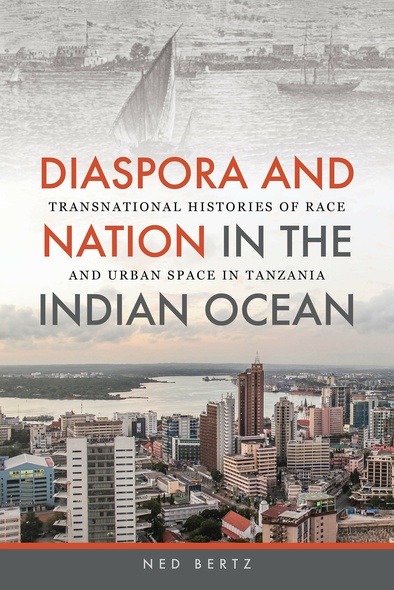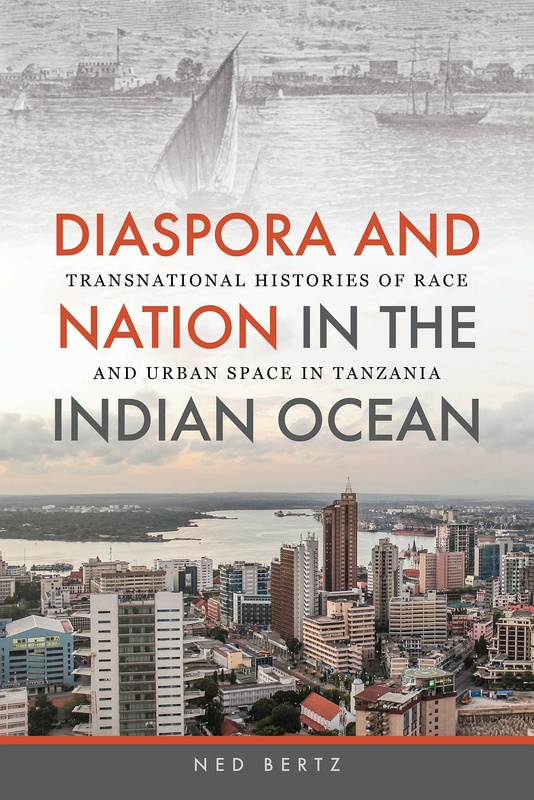Diaspora and Nation in the Indian Ocean
Transnational Histories of Race and Urban Space in Tanzania
The vibrant Swahili coast port city of Dar es Salaam—literally, the “Haven of Peace”—hosts a population reflecting a legacy of long relations with the Arabian Peninsula and a diaspora emanating in waves from the Indian subcontinent. By the 1960s, after decades of European imperial intrusions, Tanzanian nationalist forces had peacefully dismantled the last British colonial structures of racial segregation and put in place an official philosophy of nonracial nationalism. Yet today, more than five decades after independence, race is still a prominent and publicly contested subject in Dar es Salaam. What makes this issue so dizzyingly elusive—for government bureaucrats and ordinary people alike—is East Africa’s location on the Indian Ocean, a historic crossroads of diverse peoples possessing varied ideas about how to reconcile human difference, social belonging, and place of origin.
Based on a range of archival, oral, and newspaper sources from Tanzania and India, this book explores the history of cross-cultural encounters that shaped regional ideas of diaspora and nationhood from the earliest days of colonial Tanganyika—when Indian settlement began to expand dramatically—to present-day Tanzania, a nation always under construction. The book focuses primarily on two prominent city spaces, schools and cinemas: the one a site of education, the other a site of leisure; one typically a programmatic entity of government, the other usually a bastion of commercial enterprise. Nonetheless, the forces shaping schools and cinemas as they developed into busy centers of urban social interaction were surprisingly similar: the state, community organizations, nationalist movements, economic change, and the transnational winds of Indian Ocean culture and capital. Whether in the form of institutional apparatuses like networks of Indian teacher importation and curricula adoption, or through the market predominance of the Indian film industry, schools and cinemas in East Africa historically were influenced by actions and ideas from around the Indian Ocean.
Diaspora and Nation in the Indian Ocean argues that an Indian Ocean–wide perspective enables an examination of the transnational production of ideas about race against a backdrop of changing relationships and claims of belonging as new notions of nationhood and diaspora emerged. It bridges an academic divide, because historians often either focus on the Indian diaspora in isolation or write it out of the story of African nation building. Further, in contrast to the swell of publications on global Indian or South Asian diasporas that highlight longings for and contacts with the “homeland,” the book also demonstrates that much of the creative production of diasporic Indian identities formed in East Africa was a result of local (albeit cosmopolitan) encounters across cities like Dar es Salaam.
Awards
- 2017, Winner - Kenneth W. Baldridge Prize (best history book by Hawaii resident)
The book is well grounded in a range of archival, oral, and newspaper sources from Tanzania and India. . . . The strength lies in Bertz’s account of the changing debates about race carried on by Indians, Africans, and Europeans in day-to day encounters in the Indian Ocean World. New notions of migration, nation, and post colonial histories can only be under stood in terms of human experience and encounters. Bertz convincingly shifts the frame from African studies and Asian studies to the more inclusive field of Indian Ocean studies and Global History. It is a major contribution for Indian Ocean historians, sociologists, and anthropologists.
Bertz presents a nuanced argument for a wider Indian Ocean lens on the city, seeking to transcend the divides in the histories of East Africa and South Asia. . . . The book is well written and it benefits from an effective use of individual narratives to illustrate and punctuate the argument. . . . Bertz has made a useful contribution to debates on race and space in East Africa’s urban history.
Bertz’s wholistic overview provides a welcome corrective to the works of [Jonathon] Glassman and [James] Brennan, which sometimes seem to place the rise of racial animus solely on the side of Africans. After his excellent introduction, Bertz turns to his two social spaces [cinemas and schools]. He uses business and colonial records as well as oral history interviews in his analysis. His overview of the importance of cinemas as both a site of leisure and a place of social interaction that broke through colonial racial barriers is striking.
This is an engaging study of how race and space were intertwined in the colonial and postcolonial world of the western Indian Ocean. The author’s use of primary evidence, both archival and based on his wide-ranging interviews, is most impressive.
This book illuminates the debates about race between Indians, Africans, and Europeans in day-to-day encounters in the Indian Ocean world. New notions of migration, nation, and postcolonial histories can only be understood in terms of human experiences and encounters. Bertz convincingly shifts the frame from African studies and Asian studies to the more inclusive field of Indian Ocean studies.
Ned Bertz is associate professor in the Department of History at the University of Hawai'i at Mānoa.





